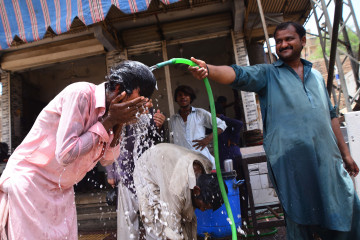

South Asia most often appears in the news as an arena for geopolitical competition. China, Russia, and the United States vie to court major players such as India and Pakistan with diplomatic, economic, and military incentives.
Today, though, the region is garnering headlines for perhaps a more ominous reason: climate change.
"Scorching temperatures have been battering the two countries since March, killing dozens and contributing to parallel food and energy shortages as well as violent floods near the Himalayas"
In the immediate future, global warming represents a threat to economies throughout South Asia. In the long term, this phenomenon will reshape the region’s way of life unless world powers act now to stop the climate crisis.
Global warming’s most recent manifestation in South Asia has come in the form of a heatwave devastating India and Pakistan.
Scorching temperatures – often in the range of 40 degrees Celsius – have been battering the two countries since March, killing dozens and contributing to parallel food and energy shortages as well as violent floods near the Himalayas. Local governments across India issued warnings about the dangers of the unprecedented heatwave.
March 2022 became the hottest March on record in India, which started tracking monthly temperatures 120 years ago.
A May 23 report by World Weather Attribution, a consortium of research centres affiliated with universities, concluded that “climate change made devastating early heat in India and Pakistan 30 times more likely.” The British Meteorological Office, a government agency, found in its own report that month that global warming “increased the likelihood of extreme April-May temperature anomalies by a factor of about 100” in South Asia.
The India Meteorological Department predicts that the rainy season will bring some relief this month, suggesting that the heatwave may soon recede from the headlines.
"The future damage that heatwaves may wreak on the Global South appear difficult to overstate"
Even so, the analyses of this phenomenon’s growing frequency indicate that India and Pakistan can ill afford to ignore the ever-present dangers of climate change to their economies and populations. The future damage that heatwaves may wreak on the Global South appears difficult to overstate.
The mango, one of India’s most prized crops, has evolved into one of the most visible casualties of the heatwave. Soaring temperatures robbed many trees of their ability to bear the delicious fruit throughout India, the largest cultivator of mangos in the world.
A heatwave that struck the country less than a decade ago and that Indian scientists linked to global warming also highlighted the human toll that climate change can have in South Asia: according to some estimates, the 2015 heatwave killed 2,000 Pakistanis and 2,500 Indians.
By no means, do India and Pakistan stand alone. Nepal, India’s far smaller, impoverished neighbour, experienced its hottest March in 53 years in 2022, and the Bangladesh Meteorological Department reported a “mild heatwave” just weeks ago. Ali Mohammad Rezaie and Savio Rousseau Rozario, a pair of scholars writing for The Dhaka Tribune, warned last month, “South Asia, a densely populated area, is considered to be a ‘hotspot’ for heatwave-related incidences.”
Climate change seems likely to exacerbate other environmental issues affecting South Asia. The World Resources Institute (WRI), a research group, included India and Pakistan on its 2019 list of countries dealing with “extremely high water baseline stress” – WRI’s most dire designation of water scarcity.
"South Asia hardly has a shortage of innovative proposals for how to tackle heatwaves and embark on a wider campaign of climate change mitigation"
The WRI report added that “in addition to rivers, lakes and streams, India’s groundwater resources are severely overdrawn, largely to provide water for irrigation,” as heatwaves induced by climate change continue to ravage agriculture there.
South Asia hardly has a shortage of innovative proposals for how to tackle heatwaves and embark on a wider campaign of climate change mitigation.
Last month, Rukhsar Sultana, a programme officer in Bangladesh for the aid agency ActionAid, wrote an op-ed for The Dhaka Tribune arguing that women should spearhead these efforts. Meanwhile, an American environmental organisation is helping India develop early warning systems for heatwaves.
Any failure in South Asia’s response to the heatwaves will likely have less to do with a lack of ideas than with the absence of a political will.
Pakistan found itself on the verge of a constitutional crisis in April when the opposition ousted Imran Khan as prime minister and replaced him with Shehbaz Sharif; the country’s government has been teetering ever since.
India, South Asia’s other regional power, seems more focused on containing China and navigating the fallout of the Russian invasion of Ukraine than on embracing costly measures for climate change mitigation.
This reluctance to develop a comprehensive strategy to counter global warming has created a patchwork of responses for dealing with the climate crisis.
"A sustainable plan for mitigating or withstanding heatwaves in South Asia will require cooperation between the region’s governments, the environmental movement, and the international community"
In India, for example, protocols and resources for bracing the population for heatwaves vary from state to state. The sense of urgency will no doubt grow, however, as this phenomenon becomes more widespread: heatwaves struck Turkmenistan and Uzbekistan at the same time as India and Pakistan.
In all likelihood, a sustainable plan for mitigating or withstanding heatwaves in South Asia will require cooperation between the region’s governments, the environmental movement, and the international community.
Only Bangladeshi, Indian, Nepalese, and Pakistani officials and their partners in civil society have the local reach necessary to rally South Asians behind climate change mitigation.
At the same time, the Western world, which, in many ways, set global warming in motion, has the greatest responsibility to put the climate crisis to an end.




 Follow the Middle East's top stories in English at The New Arab on Google News
Follow the Middle East's top stories in English at The New Arab on Google News


